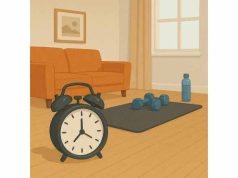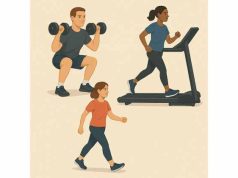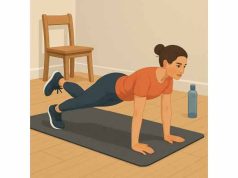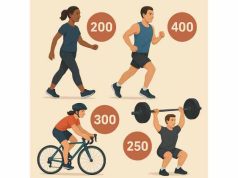
When you want to lose weight, consistency beats perfection. Still, timing your workouts can make training feel easier, fit your schedule, and support better sleep and nutrition. This guide compares morning and evening sessions for fat loss, outlines how timing influences appetite, performance, and calorie burn, and shows you how to choose your best window. If you need help building a weekly plan, see our overview of exercise methods for weight loss to pair strength, cardio, and daily steps with your routine. By the end, you’ll know what matters most—and what doesn’t—so you can train at the time that keeps you moving all week.
Table of Contents
- Does workout timing change fat loss?
- Morning workouts: pros, cons, who they suit
- Evening workouts: benefits, drawbacks, fit
- What actually matters more than the clock
- How to choose your best time
- Programming templates for AM and PM
- Troubleshooting plateaus by time of day
- Frequently Asked Questions
- Health Disclaimer
Does workout timing change fat loss?
Short answer: timing is secondary. Fat loss happens when you maintain a consistent calorie deficit while preserving muscle. Exercise helps by increasing energy expenditure, supporting lean mass, and improving metabolic health. Whether those calories are burned at 6 a.m. or 6 p.m. contributes far less than how often and how hard you train over weeks and months.
That said, timing can nudge behaviors that influence your deficit and recovery:
- Appetite and meal timing: Morning workouts may temporarily blunt appetite for some people and encourage earlier, more structured eating. Evening sessions can pair well with a substantial post-workout dinner that supports recovery without late-night snacking.
- Performance window: Body temperature, joint viscosity, and reaction time often peak later in the day. This can help you lift slightly heavier or run a bit faster in the evening, which might increase total training stimulus over time.
- Sleep quality: Early training avoids late-night arousal and caffeine. Intense workouts done too close to bedtime may delay sleep for some; others do fine if they cool down and finish a few hours before lights out.
- Adherence: The “best” time is the one you keep. Morning training wins for people whose evenings are unpredictable. Evening training wins if it reduces morning stress and lets you train fed and fully warmed up.
Research comparing morning vs. evening fat loss shows mixed results because methods, participants, and diets differ. What consistently predicts success is adherence and total training volume: a blend of resistance work, cardio, and high daily steps. For a foundation on energy balance and practical targets, skim our guide to safe weight-loss basics and then return to the timing details below.
Bottom line: Timing can shape how you feel, perform, and sleep. Choose the slot that lets you train often, recover well, and eat in line with your goals.
Morning workouts: pros, cons, who they suit
Why mornings help: Training early removes decision fatigue and reduces the odds that work, family, or social plans derail your session. It also anchors other healthy behaviors—hydration, a protein-rich breakfast, and earlier bedtime. Many people report steadier appetite control after an AM session, which can make a calorie deficit easier to maintain throughout the day.
Potential performance trade-offs: Core temperature and neuromuscular readiness are often lower in the early morning. Without a thorough warm-up, lifts may feel heavy and intervals sluggish. A structured ramp-up—light cardio, mobility, and a few progressive sets—shrinks this gap, and performance often matches later-day sessions after a few weeks of consistent mornings.
Fasted vs. fed mornings: Some enjoy light cardio before breakfast because it feels convenient. Fasted training does not guarantee more fat loss when calories are matched across the day, but it can be a practical way to accumulate moderate-intensity work. If you prefer it, keep intensity submaximal and re-feed with protein and carbs afterward. For a deeper look at pros and cons, see our overview of fasted cardio details.
Who tends to thrive in the morning:
- People with busy evenings, young children, or long commutes.
- Those who sleep best after earlier arousal and bright light exposure.
- Runners and walkers stacking steps before desk time, then topping up later.
- Anyone who finds motivation highest after waking and lowest after work.
How to make mornings work:
- Prepare the night before: Lay out clothes, fill a bottle, and set coffee and a small snack (e.g., yogurt or a banana).
- Extend the warm-up: Spend 8–12 minutes elevating heart rate and moving joints through range before loading.
- Front-load protein: Aim for 25–40 g within two hours post-workout to support recovery.
- Protect sleep: Target a consistent bedtime so early alarms don’t erode recovery.
Common pitfalls: Skipping breakfast entirely, under-warming, and letting early alarms cut total sleep below your needs. If mornings reduce sleep or make sessions chronically under-fueled, shift later.
Evening workouts: benefits, drawbacks, fit
Why evenings help: Later in the day, muscles and tendons are warm, coordination is sharper, and you’ve had time to eat. This often produces better strength and interval outputs, which can drive progressive overload and preserve muscle as you lose weight. Evening training also doubles as a stress outlet after work, lowering the urge for “treats” on tough days.
What to watch: Intense sessions within one to two hours of bedtime can delay sleep for sensitive people, especially with heavy caffeine intake. Gym crowding can add friction and shorten sessions. Planning a wind-down—cool-down, shower, dim lights—keeps arousal from spilling into the night.
Who tends to thrive in the evening:
- People who prefer larger pre-workout meals and feel strong in the late afternoon.
- Lifters prioritizing load progression or complex skills (e.g., Olympic-lift variations).
- Shift workers whose “evening” aligns with their off-duty window.
- Anyone using training to transition from work mode to home mode.
Fueling and recovery tips:
- Time your last caffeine: Cut it 6–8 hours before bedtime.
- Eat to recover, not to graze: Plan a protein- and carb-centered dinner post-workout. Avoid aimless snacking while cooking.
- Cool down on purpose: Five to ten minutes of light cardio and breathing lowers heart rate and eases sleep onset. Explore simple mobility and recovery drills you can do at home.
- Block the time: Treat the session like a meeting. Fewer skipped workouts mean better results, no matter the clock.
Common pitfalls: Letting sessions push too late, stacking high-intensity days back-to-back because evenings feel “best,” and using training as a license for late-night overeating. A little structure prevents these from eroding your deficit and sleep quality.
What actually matters more than the clock
Weight loss responds to sustainable behavior, not minute-by-minute timing. These variables move the needle most:
- Weekly strength volume: Two to four total-body sessions maintain or build muscle, which keeps resting energy expenditure higher as you diet. Prioritize multi-joint lifts (squats, hinges, pushes, pulls).
- Cardio dose and intensity: Mix steady Zone 2 with brief intervals. Accumulate 150–300 minutes per week across modalities you enjoy.
- Daily movement (NEAT): Non-exercise activity—the steps and fidgeting between workouts—can exceed formal training calories. Small habits like brisk walks, chores, and short breaks compound meaningfully. For ideas, see our rundown of daily movement strategies.
- Sleep and stress: 7–9 hours of sleep and basic stress management reduce cravings and support training quality.
- Protein and fiber: Aim for 0.7–1.0 g of protein per pound of goal bodyweight (or 1.6–2.2 g/kg) and include high-fiber foods to stay full on fewer calories.
Practical takeaway: If your timing choice improves these fundamentals—more steps, better lifts, more consistent meals—keep it. If it hurts them, change the time, not the goal.
How to choose your best time
Use this decision framework to pick a training window you can repeat four to six days per week without shortchanging sleep or work:
- Map your non-negotiables: Commute, childcare, classes, meetings. Your training must fit around these, not vice versa.
- Check sleep first: If mornings force a 5:00 a.m. alarm but you keep a 12:00 a.m. bedtime, start later. If evenings keep you wired, move earlier.
- Fueling preference: If lifting fed feels better, schedule after a meal. If you prefer light stomach, choose late morning or early evening, after a snack.
- Environment: Crowded gym vs. quiet living room. Pick the setting that minimizes friction and maximizes focus.
- Stack habits: Attach training to an existing anchor: after school drop-off, before lunch, or right after work. Then protect that block like any appointment.
Starter option: Walks are the most flexible way to accumulate calories burned without recovery debt. If you’re unsure where to start, try a daily step target and layer in strength and intervals. Our guide to walking for weight loss shows how to ramp volume safely.
Two-week experiment: Commit to mornings for 14 days, then evenings for 14. Track sleep, mood, perceived exertion, and adherence. Keep the approach that yields better performance and fewer missed workouts.
Programming templates for AM and PM
Use these plug-and-play, weight-loss-focused templates. They prioritize full-body strength, moderate cardio, and high steps. Adjust sets and minutes based on experience and recovery.
AM-biased week (45–60 minutes on training days)
- Mon: Full-body strength (3×5–10 per lift) + 10 minutes brisk walk cooldown.
- Tue: 30–40 minutes Zone 2 (bike, jog, row) + mobility.
- Wed: Steps emphasis (short walks morning/lunch/evening to hit target).
- Thu: Full-body strength + 6–8 short intervals (e.g., 45s on/75s easy).
- Fri: Off or light mobility + 20–30 minutes easy steps.
- Sat: Longer Zone 2 (45–60 minutes) outdoors if possible.
- Sun: Off or casual activity.
PM-biased week (60 minutes evenings, shorter weekend session)
- Mon: Full-body strength with progressive loading.
- Tue: Intervals (12–20 minutes hard work, separated by easy recoveries) + cooldown.
- Wed: Steps and mobility day.
- Thu: Full-body strength + accessories for weak links.
- Fri: Off or gentle walk to unwind from the week.
- Sat: 30–40 minutes steady cardio + core.
- Sun: Rest.
Busy-day swap: When time is tight, drop in a busy-day workout—a condensed strength-circuit or tempo run that finishes in 30 minutes, including a short warm-up and cool-down.
Progress rules of thumb:
- Add a rep or 2 per set before increasing load.
- Gradually extend Zone 2 by 5–10 minutes per week until you reach your target range.
- Keep one recovery day after your hardest interval or strength session.
Troubleshooting plateaus by time of day
When the scale stalls or energy dips, examine timing alongside the fundamentals.
If you train in the morning:
- Low energy during lifts: Add a small pre-workout snack (e.g., 20–30 g carbs) and extend your warm-up. Shift heavy lifts to later in the session after you’re fully alert.
- Persistent soreness: Increase protein at breakfast, add a 10-minute cooldown walk, and schedule a true recovery day after high-intensity work.
- Weight loss stalled: Audit steps and late-night calories. Early training can create hunger later—plan a fiber-rich afternoon meal instead of grazing.
If you train in the evening:
- Sleep disrupted: Finish workouts at least 2–3 hours before bedtime, limit late caffeine, and add a breathing-based cooldown.
- Nutrition drift: Pre-log dinner, prioritize lean protein and starchy carbs, and plate vegetables first to cap extra calories.
- Frequent skips: Treat sessions like a meeting, pack your gym bag in the morning, and consider a shorter at-home circuit on crash-days so the habit survives.
Anytime fixes: Increase daily steps by 1,000–2,000, cap intervals at twice per week if recovery lags, and verify you’re sleeping at least 7 hours most nights.
Frequently Asked Questions
Is it better to work out in the morning or evening for weight loss?
Neither time is universally superior. The best window is the one that keeps you consistent while supporting sleep, appetite control, and progressive training. Choose the time you can protect four to six days per week and align meals to recover well.
Do morning workouts burn more fat on an empty stomach?
Fasted cardio can increase fat use during the session, but total fat loss over weeks depends on your calorie deficit and training volume. If you prefer fasted mornings, keep intensity moderate and eat protein and carbs within a couple of hours afterward.
Will evening workouts hurt my sleep?
High-intensity sessions done too close to bedtime can delay sleep for some people. Finish hard training two to three hours before lights out, cool down with easy movement and breathing, and limit late caffeine. Many people sleep well with this buffer.
Can I split workouts between morning and evening?
Yes. Splitting can help busy schedules and reduce fatigue per session. Keep total weekly volume similar, separate intense work by at least six hours, and monitor sleep and soreness. Prioritize one strength focus and one cardio focus most weeks.
How many days per week should I do cardio vs. strength?
For fat loss, aim for two to four full-body strength sessions and 150–300 minutes of cardio, mixing steady state with brief intervals. Spread work across the week, keep at least one recovery day, and adjust volume based on soreness and sleep quality.
What should I eat around workouts for weight loss?
Center meals on protein (25–40 g) and fiber-rich carbs, with some fluids and electrolytes if sweating. Pre-workout snacks can be small and carb-focused. Post-workout meals should include protein and carbs to support recovery without overshooting calories.
References
- The efficacy of morning versus evening exercise for weight loss: A randomized controlled trial 2023 (RCT)
- Best Time of Day for Strength and Endurance Training to Improve Health and Performance? A Systematic Review with Meta-analysis 2023 (Systematic Review/Meta-analysis)
- Different Intensities of Evening Exercise on Sleep in Healthy Adults: A Systematic Review and Network Meta-Analysis 2022 (Systematic Review/Network Meta-analysis)
- WHO guidelines on physical activity and sedentary behaviour 2020 (Guideline)
- Systematic review and meta‐analysis of protein intake to support muscle mass and function in healthy adults 2022 (Systematic Review/Meta-analysis)
Health Disclaimer
The information in this article is educational and general in nature. It does not replace personalized advice from your physician, registered dietitian, or qualified fitness professional. If you have medical conditions, take medications, are pregnant or postpartum, or are new to exercise, consult a healthcare provider before changing your training or diet.
If this guide helped you, consider sharing it with a friend or colleague. You can also follow us on Facebook or X for practical training tips and new program releases. We appreciate your time and trust.










